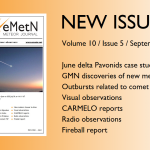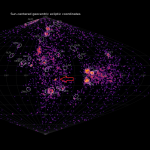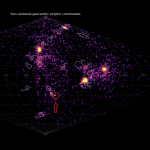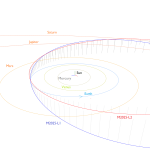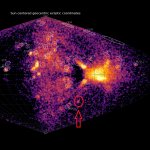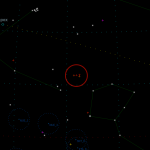A summary of the activity of the CAMS BeNeLux network during the month of May 2018 is presented. The month started with exceptional dry weather and clear nights just in time to cover the Eta Aquariid activity period. 13630 meteors were recorded, 7310 of which proved multiple station, or 54%. In total 2426 orbits were collected during this month, including many Eta Aquariid orbits.
1 Introduction
After the final few nights of April suffering from unstable cloudy sky, a period with exceptional stable weather offered excellent observing circumstances during the first 10 nights of May, providing excellent coverage of the Eta Aquariid activity. A record number of orbits for the month of May were collected, mainly during these first 10 nights.
2 May 2018 statistics
CAMS BeNeLux collected 13630 meteors of which 7310 or 54% were multi-station, good for 2426 orbits. This was the best month of May since 2012 without any single night with zero orbits. The statistics of May 2018 are compared in Figure 1 and Table 1 with the same month in previous years since the start of CAMS BeNeLux in 2012.
The CAMS station Oostkapelle with 8 cameras, a cornerstone of the CAMS network, remained out of service during May. The CAMS station at Wilderen, Belgium encountered technical problems which affected camera 380 and 381 during a series of nights. All other stations could function without major technical problems.
Less bad luck with technical problems than previous months and the general favorable weather explain the success of May 2018 with a very good coverage of the Eta Aquariids activity. The best nights occurred during the first 10 nights of May, while the next 3 weeks offered only partial clear nights as well as several nights with mostly cloudy skies. During the best nights up to 84 cameras were operational. Thanks to AutoCAMS 64 cameras were all nights operational, more than ever before. On average 91.2% of the available cameras were active, the best efficiency rate ever. This explains the high ratio of multiple station events; as many as 54% of all detected meteors were multiple station with a good orbit solution. The ratio of multiple station coincidences depends on the number of stations with clear sky during the same time span. The more stable the weather conditions are network wide and the less technical problems, the better the chances to catch a meteor from at least two stations. The exceptional dry weather in May, blessed with a lot of clear sky got close to February 2018 which had similar circumstances combined with much longer nights (Roggemans, 2018).

Figure 1 – Comparing May 2018 to previous months of May in the CAMS BeNeLux history. The blue bars represent the number of orbits, the red bars the maximum number of cameras running in a single night and the yellow bars the average number of cameras running per night.
Table 1 – May 2018 compared to previous months of May.
| Year | Nights | Orbits | Stations | Max. Cams | Min. Camas | Mean Cams |
| 2012 | 5 | 13 | 4 | 2 | 2.0 | |
| 2013 | 13 | 69 | 9 | 13 | 6.8 | |
| 2014 | 22 | 430 | 13 | 31 | 19.7 | |
| 2015 | 25 | 484 | 15 | 42 | 24.2 | |
| 2016 | 26 | 803 | 17 | 52 | 16 | 39.9 |
| 2017 | 24 | 1627 | 19 | 64 | 22 | 52.0 |
| 2018 | 31 | 2426 | 21 | 84 | 64 | 76.6 |
| Total | 146 | 5852 |
3 Conclusion
May made a brilliant start with overall very good nights during the first 10 nights, a perfect timing for an optimal coverage of the Eta Aquariids. May 2018 will likely remain the best month of May in the history of the BeNeLux CAMS network, unless mother nature has more pleasant surprises to offer in future years.
Acknowledgment
Many thanks to all participants in the CAMS BeNeLux network for their dedicated efforts. Thanks to Carl Johannink for providing all the data on which this report is based. The CAMS BeNeLux team was operated by the following volunteers during the month of May 2018:
Hans Betlem (Leiden, CAMS 371, 372 and 373), Felix Bettonvil (Utrecht, CAMS 376 and 377) , Jean-Marie Biets (Wilderen, CAMS 380, 381 and 382), Martin Breukers (Hengelo, CAMS 320, 321, 322, 323, 324, 325, 326, 327 and 328), Bart Dessoy (Zoersel, CAMS 397, 398, 804, 805 and 806), Franky Dubois (Langemark, CAMS 386), Jean-Paul Dumoulin / Christian Wanlin (Grapfontaine, CAMS 814 and 815), Luc Gobin (Mechelen, CAMS 390, 391, 807 and 808), Robert Haas (Alphen aan de Rijn, CAMS 3160, 3161, 3162, 3163, 3164, 3165, 3166 and 3167), Robert Haas / Edwin van Dijk (Burlage, CAMS 801, 802, 821 and 822), Robert Haas (Texel, CAMS 810, 811, 812 and 813), Carl Johannink (Gronau, CAMS 311, 312, 313, 314, 315, 316, 317 and 318), Hervé Lamy (Dourbes / Ukkel, CAMS 394 and 395/ 393), Koen Miskotte (Ermelo, CAMS 351, 352, 353 and 354), Piet Neels (Ooltgensplaat, CAMS 340, 341, 342, 343, 344 and 345, 349, 840), Piet Neels (Terschelling, CAMS 841, 842, 843 and 844), Tim Polfliet (Gent, CAMS 396), Steve Rau (Zillebeke, CAMS 3850 and 3852), Paul Roggemans (Mechelen, CAMS 383, 384, 388, 389, 399 and 809), Hans Schremmer (Niederkruechten, CAMS 803) and Erwin van Ballegoij (CAMS 347 and 348).
References
Roggemans P. (2018). “February 2018 report CAMS BeNeLux”. eMetN, 3, 221–222.


